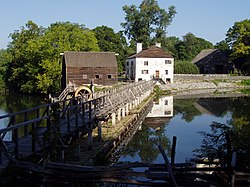Philipsburg Manor House is a historic house in the Upper Mills section of the former sprawling Colonial-era estate known as Philipsburg Manor. Together with a water mill and trading site the house is operated as a non-profit museum by Historic Hudson Valley. It is located on US 9 in the village of Sleepy Hollow, New York.
Philipsburg Manor | |
 The manor | |
 Interactive map showing the location of Phillipsburg Manor House | |
| Location | Sleepy Hollow, New York |
|---|---|
| Nearest city | White Plains |
| Coordinates | 41°05′18.7″N 73°51′49″W / 41.088528°N 73.86361°W |
| Built | 1693 |
| NRHP reference No. | 66000584 |
| NYSRHP No. | 11960.000094 |
| Significant dates | |
| Added to NRHP | October 15, 1966[2] |
| Designated NHL | November 5, 1961 [1] |
| Designated NYSRHP | June 23, 1980 |
Although an English-deeded tract, it is listed by some sources with the patroonships of New Netherland since it incorporated part of that previously owned by Dutch Jonkheer Adriaen van der Donck.
History
editThe manor dates from 1693, when wealthy Province of New York merchant Frederick Philipse was granted a charter for 52,000 acres (21,000 ha) along the Hudson River by the British Crown. He built a facility at the confluence of the Pocantico and Hudson Rivers as a provisioning depot for the family Atlantic sea trade and as headquarters for a worldwide shipping operation. For more than thirty years, Frederick and his wife Margaret, and later his son Adolph shipped hundreds of African men, women, and children as slaves across the Atlantic.[3]
By the mid 18th century, the Philipse family had one of the largest slave-holdings in the colonial North.[4] The family seat of Philipsburg Manor was Philipse Manor Hall in Yonkers
The manor was tenanted by farmers of various European backgrounds, and operated by enslaved Africans.[5] (In 1750, twenty-three enslaved men, women, and children lived and worked at the manor.)[citation needed]
At the outbreak of the American Revolutionary War, the Philipses supported the British, and their landholdings were seized and auctioned off.[6] The manor house was used during the war, most notably by British General Sir Henry Clinton during military activities in 1779. It was there that he wrote what is now known as the Philipsburg Proclamation, which declared all Patriot-owned slaves to be free, and that blacks taken prisoner while serving in Patriot forces would be sold into slavery.[7]
Named a National Historic Landmark in 1961,[1][6][8] the farm features a stone manor house filled with a collection of 17th- and 18th-century period furnishings, a working water-powered grist mill and millpond, an 18th-century barn, a slave garden,[9] and a reconstructed tenant farm house. Costumed interpreters re-enact life in pre-Revolutionary times, doing chores, milking the cows, and grinding grain in the grist mill. In 2016, historic restoration work sponsored by the New York State Council on the Arts was completed on the grist mill to rebuild the entire wooden waterwheel and flume.[10]
Further reading
edit- Michael Middleton Dwyer (editor), with a preface by Mark Rockefeller. Great Houses of the Hudson River (Boston MA: Little Brown & Co., 2001).
See also
editReferences
edit- ^ a b "Philipsburg Manor". National Historic Landmark summary listing. National Park Service. September 18, 2007. Archived from the original on June 6, 2011.
- ^ "National Register Information System". National Register of Historic Places. National Park Service. January 23, 2007.
- ^ Lewis, Tom (2007). The Hudson: A History. Yale University Press. pp. 109–112. ISBN 978-0-300-11990-9.
- ^ "Local History: Colonial Yonkers," http://www.enslavedafricansraingarden.org/history.shtml
- ^ "Philipsburg Manor, The Early Years," http://www.hudsonvalley.org/education/philipsburg-manor/early-years
- ^ a b ""Philipsburg Manor", January 1975, by James Dillon". National Register of Historic Places Inventory-Nomination. National Park Service. January 1975.
- ^ Kelley, Robin; Lewis, Earl (2005). To Make Our World Anew: Volume I: A History of African Americans to 1880. New York: Oxford University Press. p. 120. ISBN 978-0-19-518135-7.
- ^ "Philipsburg Manor--Accompanying 5 photos, exterior, from 1967 and 1974". National Register of Historic Places Inventory-Photos. National Park Service. January 1975.
- ^ "Enslaved Africans' Rain Garden," http://www.enslavedafricansraingarden.org/index.shtml
- ^ Historic Hudson Valley, "Work Begins on Large Restoration Project at Philipsburg Manor", 10-14-2016.